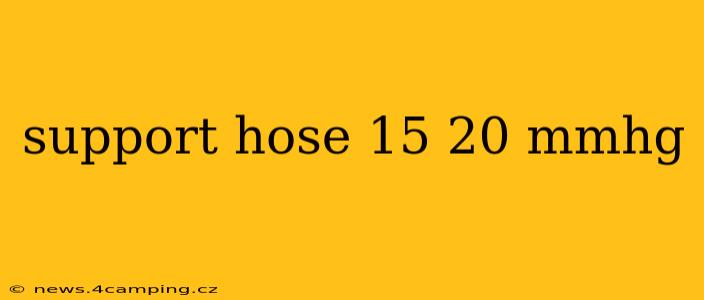Support hose, also known as compression stockings, play a vital role in improving circulation and alleviating various leg-related issues. Understanding the compression level, particularly the 15-20 mmHg range, is crucial for selecting the right product for your needs. This guide will delve into the specifics of 15-20 mmHg support hose, answering common questions and providing valuable information to help you make an informed choice.
What are 15-20 mmHg Support Hose Used For?
15-20 mmHg compression stockings are considered light support and are primarily designed for individuals experiencing mild to moderate leg discomfort. These conditions might include:
- Minor swelling (edema): Especially after prolonged periods of standing or sitting.
- Tired, achy legs: Offering relief from fatigue and heaviness in the legs.
- Varicose veins (early stages): Helping to improve circulation and prevent further development of varicose veins.
- Post-sclerotherapy: Supporting the healing process after vein treatment.
- Prevention of deep vein thrombosis (DVT) in some cases: Although stronger compression is often recommended for DVT prevention, 15-20 mmHg can be beneficial for individuals at low risk. Always consult your doctor for DVT prevention strategies.
- Pregnancy-related leg swelling: Providing comfortable support and easing leg discomfort during pregnancy.
Who Should Wear 15-20 mmHg Support Hose?
These stockings are generally suitable for individuals who experience mild leg discomfort and don't require higher levels of compression. However, it's essential to consult a doctor or healthcare professional to determine if 15-20 mmHg support hose are the appropriate choice for your specific needs and condition. They can assess your individual circumstances and recommend the correct compression level.
Are 15-20 mmHg Support Hose the Same as Compression Stockings?
Yes, 15-20 mmHg support hose and compression stockings are essentially the same thing; the terminology is often interchangeable. The number (mmHg) indicates the level of compression applied to the leg.
What is the Difference Between 15-20 mmHg and Other Compression Levels?
Compression stockings are available in various compression levels, each designed for different conditions and severities:
- 8-15 mmHg: These are considered "light support" and are often used for everyday wear to improve circulation and prevent fatigue.
- 15-20 mmHg: As discussed, this provides mild to moderate support for various leg issues.
- 20-30 mmHg: This is considered "moderate support" and is usually prescribed for moderate varicose veins, leg ulcers, and post-surgery recovery.
- 30-40 mmHg: This level provides "firm support" and is recommended for severe conditions such as advanced venous insufficiency and post-thrombotic syndrome.
- >40 mmHg: This level of compression is typically used for managing severe lymphedema and requires a prescription.
Always follow the advice of your doctor or healthcare professional when selecting the correct compression level.
How Do I Choose the Right Size of 15-20 mmHg Support Hose?
Proper sizing is crucial for effectiveness and comfort. Manufacturers provide detailed sizing charts based on height and weight, or leg measurements. Accurately measuring your legs and referring to the size chart provided by the manufacturer will ensure a proper fit. Ill-fitting stockings can be ineffective or uncomfortable.
How Long Can I Wear 15-20 mmHg Support Hose Each Day?
Generally, you can wear 15-20 mmHg support hose for extended periods, potentially all day. However, it's important to take breaks if you experience any discomfort or notice any signs of impaired circulation. It's also advisable to remove them at night to allow for better blood flow during sleep.
Where Can I Buy 15-20 mmHg Support Hose?
15-20 mmHg support hose are widely available at pharmacies, medical supply stores, and online retailers. When buying online, ensure you are purchasing from a reputable source to avoid counterfeit products.
This information is for general knowledge and should not be considered medical advice. Always consult a healthcare professional for personalized guidance on the appropriate compression level and use of support hose.
